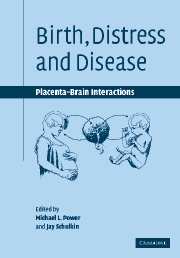Book contents
- Frontmatter
- Contents
- List of contributors
- Preface
- Introduction: brain and placenta, birth and behavior, health and disease
- 1 Placental expression of neurohormones and other neuroactive molecules in human pregnancy
- 2 The regulation of human parturition
- 3 Maternal nutrition and metabolic control of pregnancy
- 4 Fetal HPA activation, preterm birth and postnatal programming
- 5 Prenatal glucocorticoids and the programming of adult disease
- 6 Prenatal stress and stress physiology influences human fetal and infant development
- 7 Glucocorticoids and the ups and downs of neuropeptide gene expression
- 8 Glucocorticoid facilitation of corticotropin-releasing hormone in the placenta and the brain: functional impact on birth and behavior
- Index
4 - Fetal HPA activation, preterm birth and postnatal programming
Published online by Cambridge University Press: 16 October 2009
- Frontmatter
- Contents
- List of contributors
- Preface
- Introduction: brain and placenta, birth and behavior, health and disease
- 1 Placental expression of neurohormones and other neuroactive molecules in human pregnancy
- 2 The regulation of human parturition
- 3 Maternal nutrition and metabolic control of pregnancy
- 4 Fetal HPA activation, preterm birth and postnatal programming
- 5 Prenatal glucocorticoids and the programming of adult disease
- 6 Prenatal stress and stress physiology influences human fetal and infant development
- 7 Glucocorticoids and the ups and downs of neuropeptide gene expression
- 8 Glucocorticoid facilitation of corticotropin-releasing hormone in the placenta and the brain: functional impact on birth and behavior
- Index
Summary
Activation of the fetal hypothalamic—pituitary—adrenal (HPA) axis in late gestation is a common characteristic across species resulting in increased output of fetal glucocorticoids, contributing to mechanisms associated with the onset of parturition and maturation of organ systems required for extrauterine survival. The fetus responds to an adverse intrauterine environment with precocious HPA activation, and premature upregulation of critical genes at each level along the axis. Thus in utero the fetus may be exposed inappropriately to sustained elevations of glucocorticoids. In addition, fetal glucocorticoid concentrations may be elevated in circumstances of maternal stress, particularly in association with diminished activity of placental 11β-hydroxysteroid dehydrogenase type 2 (11β-HSD2) activity, or after maternal administration of synthetic glucocorticoids. Animal studies have demonstrated that glucocorticoid administration in late gestation results in intrauterine growth restriction (IUGR) and significant alterations in metabolic and HPA axis function and regulation.
These associations among elevated fetal glucocorticoid concentrations and growth and development may underlie the increased incidence of spontaneous preterm labor in small-for-gestational-age babies. They possibly contribute to mechanisms by which aberrant development in utero predisposes to different pathophysiologies in later life. Over the last 10–15 years epidemiological studies have shown that a suboptimal intrauterine environment is associated with an increased risk of developing cardiovascular disease, hypertension, type 2 diabetes and ‘syndrome X’ (metabolic syndrome).
- Type
- Chapter
- Information
- Birth, Distress and DiseasePlacental-Brain Interactions, pp. 114 - 141Publisher: Cambridge University PressPrint publication year: 2005



